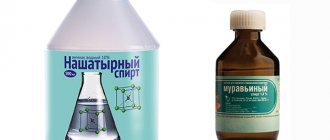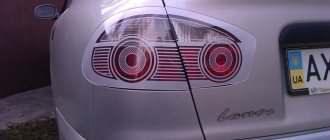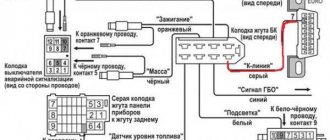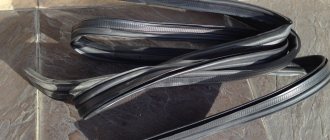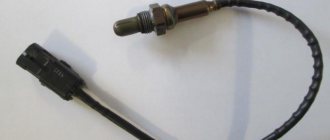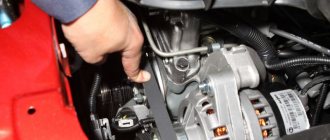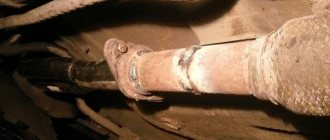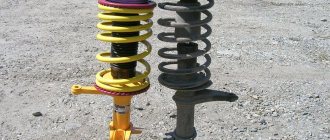One bad thing happened to me, after buying the car I went to register it, and the tint on the rear lights did its job, they didn’t register the car, I couldn’t think of anything from a bribe to new headlights, but the funds didn’t allow me, I decided to get rid of the toner myself . Several methods were tried, including brake fluid, various solvents, but they did not give the desired result. The paint held on like a partisan during interrogation. It was decided to polish. After a trip to the auto and hardware stores, the following were purchased: 1. Set for polishing headlights - LAVR
It includes 3 types of sandpaper numbered 1-2-3 Number 1, respectively, the coarsest grit - 800, Number 2, medium grit 1500, Number 3, the smallest grit 2000. The set included a polishing compound consisting of wax and abrasive for finishing . We also purchased 400-grit grinding wheels for directly removing varnish from headlights (the roughest treatment) and a grinding wheel.
How to remove tint from headlights
Nikittaa 09.14.2008 - 10:03
(The car is really Russian, well, the varnish seems to come from a spray can that they sell in the markets)
Post edited by Nikittaa: 09.14.2008 - 13:06
Greetings! Optical tuning has been very popular lately. You can do anything with the headlights: xenon, bi-xenon, LEDs, eyelashes, tinting. The only question is how legal and practical is all this?
Not everyone likes all these modifications, and sometimes the “beauty” that was created by the previous owner has to be corrected by the new owner of the “tuned” car. It is also not uncommon to have to refuse and return the optics to their original condition due to refusal to undergo technical inspection. Yes, yes, it happens. When, because of your “cool” optics, you cannot pass a technical inspection or constantly receive fines and comments from the traffic police, then whether you like it or not, you need to somehow solve the problem.
If there is xenon and you get a lot of trouble because of it, remove it and bring the headlights into compliance with the requirements. If these are LEDs, put the halogens back. If it is a tint film, remove it. What if it's varnish? In this case, you will have to sweat.
In this article I’ll tell you about working (and not so working) methods for removing tinted varnish. You will learn how to effectively remove tint from headlights without damaging them.
So, I’ll start with the least effective, in my opinion, gradually moving on to more workable methods
- Glass replacement. Complete replacement of the headlight glass is a radical method; only a complete replacement of the headlight assembly will be more radical. The process is labor-intensive and requires certain skills and tools, as well as spare glasses. The headlights warm up, after which the sealant softens and allows the glass to separate from the body.
- Mechanical removal. I also consider this method of removing varnish from headlight glass to be radical and recommend using it only if other means have failed. This option involves removing headlight tint using an abrasive. That is, roughly speaking, sandpaper will be used, with which the varnish layer will be erased. The disadvantage of this method is that it is labor-intensive and also radical; the top layer of glass will be removed along with the varnish layer, which will lead to clouding and weakening of its protective properties.
- Nail polish remover (for nails). The principle is this: apply a little product to a rag, wet the painted area, and then quickly remove everything using a rag soaked in solvent. If you delay or do not calculate it, you can get the opposite effect - the plastic will become cloudy or white. In general, there is a high probability of destroying the glass.
- Professional liquid for removing tinted varnish. This product is specially designed for such work, so there should be no harm from it, and the effect is usually positive. Of course, this is not cheap, but it is many times cheaper and more convenient than buying new glass or sanding it with sandpaper. In addition, the simplicity of the method should be taken into account. Unlike all those described above, it is tritely simple: we apply the product to the tint and give the liquid time to react. After the varnish begins to swell, remove it with a rag.
How to remove tinted varnish from headlights?
Friends, has anyone found out how to remove the tinting varnish from the rear lights so that the transparent plastic of the light does not become cloudy?
With fine sandpaper and always with some water, and then the paper “3m” - 3 numbers and they will be like new!
wow! what sandpaper!) there is a special liquid just for wiping off the tarnish! It is sold in the same place where the tint is sold!
Don't remember what it's called? Doesn't the plastic become cloudy after this?
sandpaper + polish is a proven product, and then you apply it together with the plastic and you’ll end up on new fans))) But I won’t say that because maybe a good product, but I would probably decide to apply it to the VAZ 2109, it’s not a shame to experiment there)))))
if the optics are original, then nothing will happen!
Is it really possible that the plastic on the replica is made from...
solvent, but special markings. I don’t remember what letters and numbers are already, I’ll have to ask the painters. the headlights will become a little cloudy, but polishing will remove everything
original optics. I'll try to look for a remedy in the store. If I can’t find it then sanding + polishing
By the way, as an option, not an evil solvent + polishing. What if I borrow nail remover from my wife?
I don’t know what will happen from a nail remover that does not contain acetone. But it is better to keep acetone away from the car, because it also dissolves plastic.
How to remove glue from glass tinting
Using a hair dryer by professionals is considered the best method. Without the use of chemicals, it will be possible to remove not only the film, but also glue residues. To do this, the glass is heated and unsightly marks are wiped off with special napkins. Some people use a steam generator: they heat the glass with steam, removing glue stains. Both methods are far from safe and should be practiced with great caution. Beginners should try easier methods using a chemical approach.
Soap solution
Glue residues are easily removed after softening in a soap solution. Using a knife or scraper right away is dangerous - there is a risk of scratching the glass. It is necessary to dilute laundry soap in warm water, moisten a rag, and wipe the glass. It must be moistened regularly, not allowing the water to dry out. After a few minutes, you can begin to separate the glue with a plastic, hard rubber scraper. Remaining glue can be wiped off with a napkin. For a more pronounced softening effect, some people add a little ammonia to the soap solution.
Degreasing solution
The principle of its operation is similar to that of a soap solution. Car detergent is added to water, whipped into foam, and applied to the window. After complete drying, wash the glass with a washcloth, removing any remaining glue. Wipe dry with a rag.
Rust converter
Such products are sold in sprays and suspensions; they are intended to dissolve and remove rust. The preparations can also be used against glue stains, but only with caution - the toxicity to the body is high. When working, it is better to drive the car out of the garage into fresh air, and you should also not forget about gloves. The converter is sprayed directly onto the glue stains, and after 10 minutes the windows are wiped with a cloth. StarWax, which is sold in automotive and hardware stores, has proven itself well.
Use of solvents
To get rid of glue, you can use solvents - acetone, white spirit. A rag should be moistened in one of them, rinse the glue stains well, and leave to dry. After 3-4 minutes, you can remove the softened adhesive using a plastic card, scraper, or spatula. Smoking is strictly prohibited during the procedure, the materials are highly flammable!
Petroleum-containing substances
Such products also belong to the category of organic solvents and can wash away the adhesive from the film (kerosene, gasoline). You need to thoroughly wipe the glass with a cloth soaked in these solvents. After a couple of minutes, the glue will soften and can be cleaned with a plastic scraper. Due to the toxicity, be sure to wear a respirator when working with solvents in the garage! You must also be careful not to stain the seat upholstery with petroleum products.
"Super Moment Anticley"
This product can also remove adhesive residue. It is sold in tubes, in gel form, does not flow, and can be conveniently applied to any surface. Anti-glue can remove any glue stains, even those based on cyanoacrylate. It is necessary to apply it to the glass in a thin layer and leave for 20-60 minutes (depending on the thickness of the adhesive coating). During this time, the connection to the surface will be destroyed, after which the remaining glue can be easily washed off with soap and water.
Biosolvent "Citosol"
This drug is created on the basis of biologically active components, it is absolutely harmless, it breaks down in water in 4 days. You can use Cytosol against stains from bitumen, adhesive tape, and vinyl film; it is excellent for cleaning glass and car bodywork. The product is applied to the glass, after half an hour the surface is washed well.
Household water repellents
Anti-rain preparations are also popular among drivers. These are hydrophobic products that disperse water after application to headlights, lanterns, and windshields. In addition to their intended purpose, sprays can be used to clean glass from glue. You just need to spray the stains with the solution, wait until the glue softens, then remove the residue with a plastic spatula.
Profoam 2000
This brand's universal cleaner easily removes remaining tape, stickers, tint film, and marker traces. With its help, you can tidy up not only the glass, but also the interior of the car, plastic parts, wipe off grease, technical grease, and dirt around the components. You need to spray the aerosol, after 30 seconds wipe off the glue with a napkin, then rinse the glass with water.
Liquid for cleaning the body from insects
Most of these products quickly cope not only with traces and stuck insect particles, but also with stains of glue and bitumen. Usually they are sprayed, then wiped off with a napkin along with the dirt. Automotive stores sell many different brands of products. The most popular are Bag Blitz, Insect Remover, Hi-Gear HG5625 and others.
Glue cleaners ZM 08184 or ZM 08984
Such products belong to the group of adhesive cleaners, therefore they can easily rid the surface of traces of adhesives, as well as mastic, bitumen, wax, and polishing. They are also suitable for cleaning glass from tinting adhesive. The material is highly flammable and must be handled with care. A small amount of cleaner should be applied to a napkin, wipe the dirty areas, and repeat if necessary.
Coating headlights with varnish
There is no need to spray the varnish too early after degreasing. Residual degreaser must evaporate completely before applying varnish, otherwise it will continue to evaporate after varnishing, impair adhesion and cause “boiling” defects (see paint defects).
The varnish layer should be thin. Although polycarbonate's surface tension is higher than some difficult-to-paint plastics, it is still lower than other easily painted materials. If you immediately apply a thick layer, something like small cracks will appear. Several very thin layers with drying between layers give a good result.
The varnish should not contain a lot of solvent, as it can affect the plastic, but it should not be thick either. The solvent can either promote adhesion to the plastic or destroy it, depending on the amount. The solvent helps the varnish to eat into the plastic, but a large amount of it can cause excessive dissolution of the plastic.
On-site tinting
Car headlights are tinted in two ways: varnish or film.
Both the first and second methods have advantages and disadvantages.
Film from car headlights can be quickly removed, unlike varnish. When heated with a hairdryer, it comes off faster. If there is any glue left from the film, it can be washed off with a special liquid that is sold in stores that sell advertising films. For example in Remex. By the way, it also removes glue from vinyl/carbon films well.
How to remove varnish from headlights
Tinted varnish can also be removed from plastic car headlights, but it is much more difficult. You can remove the varnish layer with sandpaper and then polishing (When polishing by hand, it will take longer). First, 2000 sandpaper is used, then 3000, and then if you polish it all with 3M paste No. 2 - 3, then the headlights will become as good as new. It is better to remove the headlights in this case, and if you decide to do this without removing the headlights, then you need to cover the body and bumper elements around the headlights with masking tape so as not to damage them.
It is not recommended to remove the varnish with a solvent or acetone, as it will “corrode” the plastic headlights and they will become cloudy, and it can penetrate “deep” into the plastic. Although there are cases when the varnish from headlights was removed with a solvent - but very carefully.
The film for headlights in the color of the car body is usually not very transparent and the headlights are difficult to see during the day, which can affect traffic safety.
You can choose any degree of darkening with varnish for car headlights, since the varnish is applied in many layers, and there are only several types of darkening films.
All work is provided with a lifetime warranty.
Tinting. Tinted glass. Car window tinting. On-site tinting. Window tinting outcall. On-site car window tinting. Car departure tinting. Toning training. Car tinting training. Tinting training. Car tinting training. Tint center. Tinting Training Center.
— We create comfort for you and your family!
tonirovku.ru
